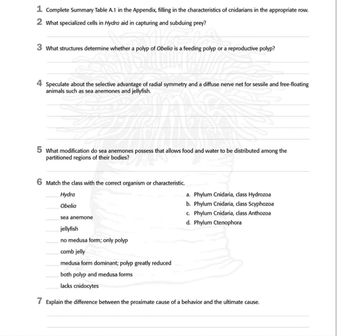
Human Anatomy & Physiology (11th Edition)
11th Edition
ISBN: 9780134580999
Author: Elaine N. Marieb, Katja N. Hoehn
Publisher: PEARSON
expand_more
expand_more
format_list_bulleted
Question

Transcribed Image Text:1 Complete Summary Table A.1 in the Appendix, filling in the characteristics of cnidarians in the appropriate row.
2 What specialized cells in Hydra aid in capturing and subduing prey?
3 What structures determine whether a polyp of Obelia is a feeding polyp or a reproductive polyp?
4 Speculate about the selective advantage of radial symmetry and a diffuse nerve net for sessile and free-floating
animals such as sea anemones and jellyfish.
5 What modification do sea anemones possess that allows food and water to be distributed among the
partitioned regions of their bodies?
6 Match the class with the correct organism or characteristic.
Hydra
Obelia
sea anemone
jellyfish
no medusa form; only polyp
comb jelly
medusa form dominant; polyp greatly reduced
both polyp and medusa forms
lacks cnidocytes
a. Phylum Cnidaria, class Hydrozoa
b. Phylum Cnidaria, class Scyphozoa
c. Phylum Cnidaria, class Anthozoa
d. Phylum Ctenophora
7 Explain the difference between the proximate cause of a behavior and the ultimate cause.
Expert Solution
This question has been solved!
Explore an expertly crafted, step-by-step solution for a thorough understanding of key concepts.
Step by stepSolved in 2 steps

Knowledge Booster
Similar questions
- An unidentified animal is noted to possess the following characteristics: triploblastic eucoelomate body a cuticle that is shed via ecdysis To which of the following phyla does this organism belong? Group of answer choices A. Echinodermata B. Annelida C. Arthropoda D. Nematodaarrow_forwardStarfish Oral Side Describe the structures of the oral side of starfish. Such as peristome, ambulacral grooves, and tube feet.arrow_forward(This is a book question, NONGRADED) List at least three features of squid that contribute to their sucess as predators.arrow_forward
- Leeches are members of the phylum _ in the clade of bilaterally symmetric animals called _ (Nematoda; ecdysozoa/platyhelminthes;Deuterostomia/Cnidaria;lophotrochozoan/annelida;lophotrochozoa)?arrow_forwardQuestion: Craniata includes animals within Chordata that have a skull. True or False?arrow_forwardConsidering the presence of segmentation (metameres) in their body to which other already studied phylum are arthropods proximal?arrow_forward
arrow_back_ios
arrow_forward_ios
Recommended textbooks for you
 Human Anatomy & Physiology (11th Edition)BiologyISBN:9780134580999Author:Elaine N. Marieb, Katja N. HoehnPublisher:PEARSON
Human Anatomy & Physiology (11th Edition)BiologyISBN:9780134580999Author:Elaine N. Marieb, Katja N. HoehnPublisher:PEARSON Biology 2eBiologyISBN:9781947172517Author:Matthew Douglas, Jung Choi, Mary Ann ClarkPublisher:OpenStax
Biology 2eBiologyISBN:9781947172517Author:Matthew Douglas, Jung Choi, Mary Ann ClarkPublisher:OpenStax Anatomy & PhysiologyBiologyISBN:9781259398629Author:McKinley, Michael P., O'loughlin, Valerie Dean, Bidle, Theresa StouterPublisher:Mcgraw Hill Education,
Anatomy & PhysiologyBiologyISBN:9781259398629Author:McKinley, Michael P., O'loughlin, Valerie Dean, Bidle, Theresa StouterPublisher:Mcgraw Hill Education, Molecular Biology of the Cell (Sixth Edition)BiologyISBN:9780815344322Author:Bruce Alberts, Alexander D. Johnson, Julian Lewis, David Morgan, Martin Raff, Keith Roberts, Peter WalterPublisher:W. W. Norton & Company
Molecular Biology of the Cell (Sixth Edition)BiologyISBN:9780815344322Author:Bruce Alberts, Alexander D. Johnson, Julian Lewis, David Morgan, Martin Raff, Keith Roberts, Peter WalterPublisher:W. W. Norton & Company Laboratory Manual For Human Anatomy & PhysiologyBiologyISBN:9781260159363Author:Martin, Terry R., Prentice-craver, CynthiaPublisher:McGraw-Hill Publishing Co.
Laboratory Manual For Human Anatomy & PhysiologyBiologyISBN:9781260159363Author:Martin, Terry R., Prentice-craver, CynthiaPublisher:McGraw-Hill Publishing Co. Inquiry Into Life (16th Edition)BiologyISBN:9781260231700Author:Sylvia S. Mader, Michael WindelspechtPublisher:McGraw Hill Education
Inquiry Into Life (16th Edition)BiologyISBN:9781260231700Author:Sylvia S. Mader, Michael WindelspechtPublisher:McGraw Hill Education

Human Anatomy & Physiology (11th Edition)
Biology
ISBN:9780134580999
Author:Elaine N. Marieb, Katja N. Hoehn
Publisher:PEARSON

Biology 2e
Biology
ISBN:9781947172517
Author:Matthew Douglas, Jung Choi, Mary Ann Clark
Publisher:OpenStax

Anatomy & Physiology
Biology
ISBN:9781259398629
Author:McKinley, Michael P., O'loughlin, Valerie Dean, Bidle, Theresa Stouter
Publisher:Mcgraw Hill Education,

Molecular Biology of the Cell (Sixth Edition)
Biology
ISBN:9780815344322
Author:Bruce Alberts, Alexander D. Johnson, Julian Lewis, David Morgan, Martin Raff, Keith Roberts, Peter Walter
Publisher:W. W. Norton & Company

Laboratory Manual For Human Anatomy & Physiology
Biology
ISBN:9781260159363
Author:Martin, Terry R., Prentice-craver, Cynthia
Publisher:McGraw-Hill Publishing Co.

Inquiry Into Life (16th Edition)
Biology
ISBN:9781260231700
Author:Sylvia S. Mader, Michael Windelspecht
Publisher:McGraw Hill Education